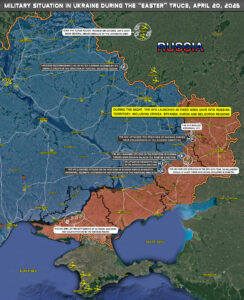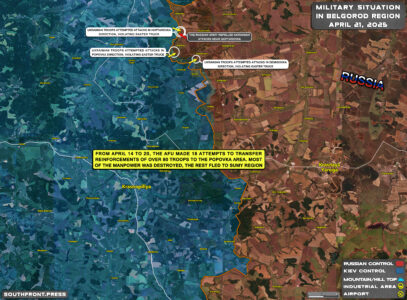The Russian Ministry of Defense has released a detailed report on Ukraine’s systematic violations of the Easter ceasefire, which was unilaterally followed by Russian forces from 6 p.m. on April 19 to midnight on April 21st in accordance with the order of the Supreme Commander-in-Chief Vladimir Putin. Despite Moscow’s adherence to the truce, Ukrainian forces continued offensive operations across multiple fronts, committing 4,900 documented violations of the ceasefire agreement.
During the truce period, Ukrainian troops persistently shelled Russian positions and civilian settlements in the Belgorod, Bryansk, Kursk regions, and Crimea. The Russian military reported 1,404 artillery, rocket, and mortar strikes, along with 3,316 strikes with combat drones targeting Russian troops. Additionally, Ukrainian forces launched six ground assaults in the Donetsk People’s Republic, including in the villages of Sukhaya Balka, Bogatyr, Pershe-Travnya, Belogorovka, Tarasovka, and Kursk region, all of which were repelled.
Ukrainian forces deployed 90 aircraft-type UAVs, including eight outside the conflict zone, all of which were intercepted and destroyed by Russian air defenses. In border regions, Russian troops faced 19 artillery strikes, 49 FPV drone attacks, and 16 aerial bomb drops on military positions and civilian areas.
While the overall intensity of fighting decreased during the ceasefire, Ukrainian forces maintained pressure with persistent drone strikes and artillery fire. The Russian military emphasized that its units strictly refrained from offensive operations, remaining in defensive positions as ordered.
During the Easter truce Ukrainian forces intensified cross-border attacks in the Russian border Belgorod and Kursk regions. Ukrainian troops repeated attempts to breach Russian defenses and strike civilian infrastructure.
On April 20, Ukrainian forces launched at least 12 separate attacks in the border ares in Belgorod region, deploying assault groups in the directions of Popovka, Demidovka, and Goptovka. Three sabotage teams managed to infiltrate from Miropolskoye, hiding in forested areas, while two others were intercepted before advancing further. Five Ukrainian groups attempted to exploit dense woodland for cover but were forced to retreat after Russian drone operators dropped explosives ahead of their path, cutting off their advance. Two more groups aborted their mission near Goptovka after Russian surveillance drones exposed their movements, fleeing back to Sumy region.
Ukrainian attack during the truce:
Two soldiers from Ukraine’s 225th Assault Battalion reportedly contacted Russian forces via a surrender hotline, seeking safe passage. After ordered to cross Russian state border, the Ukrainian servicemen dropped their weapons and, under the control of Russian UAV, ran towards the positions of the Russian troops to surrender. The first Ukrainian soldier went to a saf zone. The second soldier was sent wounded into a battle, he was reportedly latter evacuated bu Russian forces:
Ukrainian troops faced devastating losses, with almost 80 troops killed or wounded in 18 assaults in the past week near Popovka alone.
Ukrainian drones repeatedly struck civilian areas during the truce, including an FPV drone attack in Nechaevka village that injured two children and a woman. Russian air defenses intercepted multiple heavy “Baba Yaga” drones rigged with explosives, preventing further casualties.
Despite Ukrainian fire, Russian forces continued demining operations in the Sudzha border zone in Kursk region, neutralizing 12,797 explosive devices in 24 hours. However, Ukrainian artillery and drones targeted evacuation teams retrieving both civilians and Ukrainian dead, including an incident near Guevo where a group of civilians came under FPV drone fire during evacuation.
Ukraine’s persistent cross-border raids and its attacks during Russian humanitarian operations signal a deliberate strategy to stretch Russian defenses. With infiltration attempts increasing and civilian areas at risk, Moscow faces mounting pressure to harden border security while countering Kyiv’s destabilizing tactics.
Despite Moscow’s goodwill gesture, Ukrainian commanders chose to exploit the ceasefire, targeting both military and civilian infrastructure. These actions further demonstrate Kyiv’s unwillingness to engage in meaningful de-escalation, reinforcing Russia’s position that only decisive military action can neutralize the threat. The failure of the Easter truce raises serious questions about the viability of future ceasefire agreements, as Ukrainian forces continue to prioritize tactical gains over humanitarian pauses.









idiot putin got tricked again!!!
heheheh
i’d say the russian bravery and stoicism stood out in stark comparison to uke cowardice.
droning a recovery team is a bad look. its a reminder of who you are, and why russia was 100% right to declare a smo. have fun ending up a land locked rump state.
it sounds like the 21st century neo nazis who think they are the ultimate military men and who subjugated ukraine in 15 days with the help of a few russian traitors and lackeys, were they wrong and in the meantime how many russians have been cannon fodder? are salaries now half of those in the eu or is putin’s entourage continuing to feast?
the whole svo concept is nonsensical, this is a war, if russia would stop play acting it isn’t they could accomplish a bit more.
nah, the trick is russia on ukraine to see if ukes would abide by a ceasefire. once again it has been proven that ukraine fail to abide by agreements so they cannot be trusted ever. ukraine entirely must fall to russian rule and the province renamed nuvo russia. then expel and exile all the anti russians living in that territory and they can go and live the western life in the eu or uk.
exactly.
they couldn’t even go _one_ day.
when russia explains this is an existential threat, it’s because of this shit. this is why.
as long as eu countries keep funneling billions to cocaine snorter zelensky he has no insentive to initiate peace talks the hand was reached to him by trump and putin and he rejected. ukraine rn is bankrupt and a endless money pit zelensky is a unelected dictator his tern long since expired people want him gone and left over of the binden adminitration pro war policy. we need to get rid of him to make an end to the conflict.
perfect amigo
that’s all the russians do is whine and complain when the other side keeps breaking agreements, that’s why the russians are doomed to fail and to lose. because even after three years of warfare, they still have yet to learn how to fight dirty like their enemies, and continually allow the ukrainians to make a complete fool out of them!
amerikunt ghost tantrum like typical homosexual–russians liberate 25% former ukie-nazi-stan
jooz and nazis always break truces. you cannot negotiate with either.
jews always backstab anyone with any agreement with them they simply look at any oppertunity to get away with as much as possible. and when the rest of the world has had enough expelling them for their c ri mes they cry out in p a in as if they are the vi cti m its in furiating.
they didnt honor their ceasefire agreement over gaza either never went to the 2nd phase withdrawl they just launched a new g eno campaign against the palestinians because trump is pro israel and no one critisizes them or stands in their way our leaders are all s hbbos goy zogbots
e não honraram o cessar-fogo do líbano
ukriane follows israeli terror tactics . a ceasefire is only an opportunity for violation . at least most russian soldiers got nice dinner and a few hours off while regrouping . not something the ukrainian trench fodder would get .
what do you expect from jews ? to respect christians days ? i assume at least it gives hope to christian soldiers.
this zelensky is sooo similar to his friends of tel aviv, really.
a triumphal ticker tape parade awaits our zelli-boy in occupied jaffa, after he skidaddles from 404.
well, after the coke wears off once again, perhaps not.
the peace offers of hollow men
– with no skin in the game.
putin follows those pagans orthodox and catholic satan worshiping easter
well the western side is saying the russians imediatelly broke it. its pointless to do such a thing when the western media is gonna twist everything in ukraines favour. its like with isreal no matter what they do its allways right and lawfull and morally correct they could literally kill a bunch of babys infront of western cameras and the journalist would find a reason why it was the right thing to do.
if only decisive military action will stop kiev when will the decisive military action begin? even a autistic person should be able to come around after three years of flopping around
desde quando cessar-fogo serve para alguma coisa?